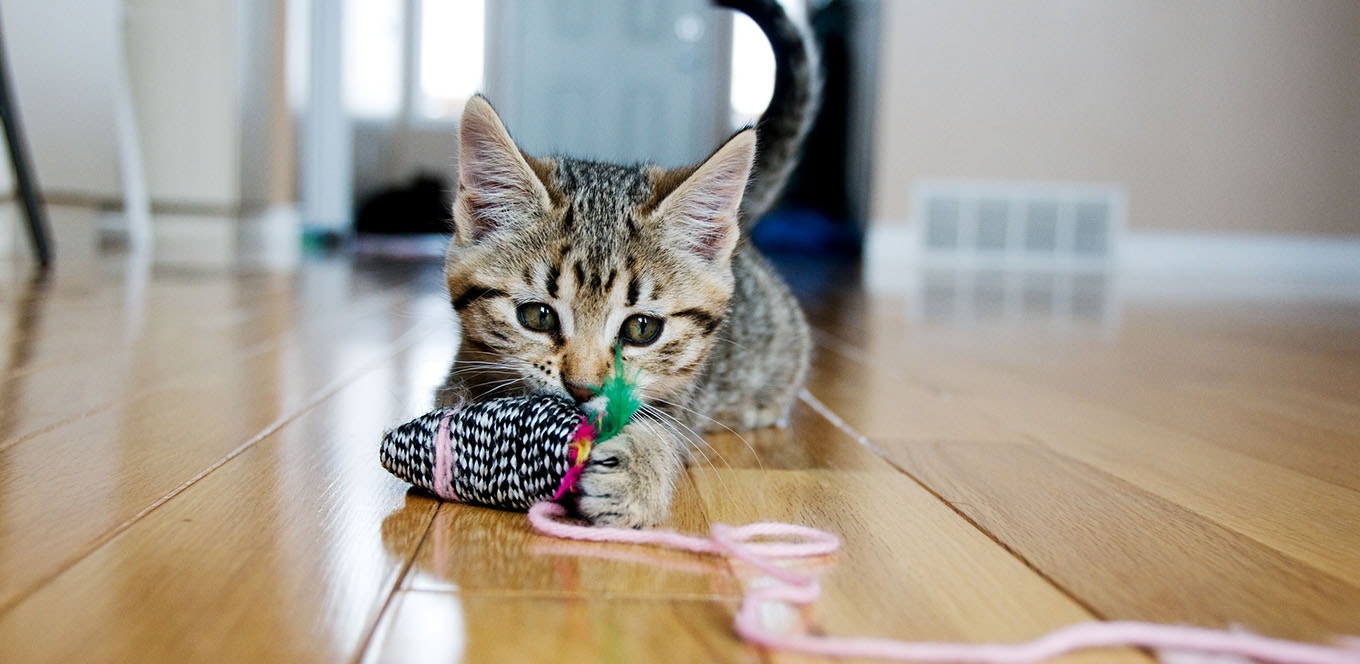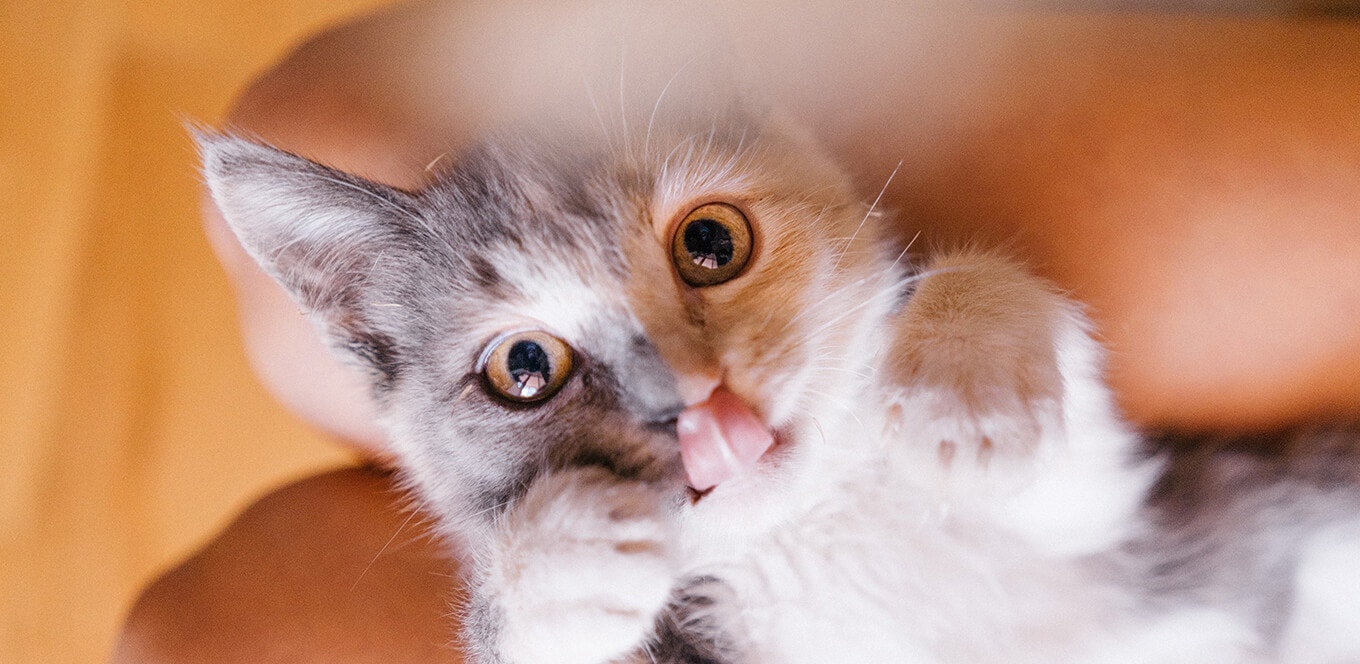

Providing your kitten with the proper nutrition goes way beyond just putting fresh food in a clean bowl. Your kitten’s nutritional needs will change as her body develops through adolescence. Proper nutrition during these critical growth periods will help your kitten mature into a strong, healthy adult cat. Discover four essential kitten-feeding tips you need to know in your kitten’s first year.
Learning what development milestones your kitten will experience in her first year will help you decide what and when to feed her.
After kittens are weaned, they enter a stage of rapid growth, which lasts through the sixth month of life. They need a balanced diet to deliver the nutrients and energy to sustain such rapid development.
Kittens have twice the energy needs of adult cats on a pound-per-pound basis. But their smaller mouths, teeth and stomachs limit the amount of food they can digest during a single meal. Therefore, it may be best to divide their total daily food amount into three or four smaller meals.
Because every bite must be packed with nutrition, kittens require a diet specifically formulated for growth. The best choice is a food with animal-based proteins that is highly digestible, nutrient dense and designed to meet kittens’ unique nutritional needs.
As kittens approach adult size, their nutritional requirements begin to change again. Their rate of growth begins to slow, activity levels may decline and they can start eating fewer, larger meals each day. During this stage, kittens begin to look like adults, but they are still growing and need the special nutrition found in kitten food.
The adolescent growth stage is a time when many cat owners are tempted to change a kitten’s food for variety. But cats do not get bored with a consistent diet of high-quality dry food. You can supplement your kitten’s dry food with a nutrient-dense canned food for a nutritious change of pace.
When your cat is about 12 months old, it’s time to switch to a maintenance formula adult cat food, such as IAMS™ ProActive Health™ Healthy Adult with Chicken. At this age, cats no longer need the extra calories and nutrients for growth supplied by kitten food. As with any change in a cat’s diet, remember to gradually transition from kitten food to adult food over a period of several days.
Monitor your cat’s weight and body condition during the transition, and adjust feeding portions if necessary. Because cats generally eat only what they need, free-choice feeding is fine for most cats. However, some indoor cats that don’t exercise much may overeat if fed free choice. In this situation, portion-controlled feeding twice a day is a good alternative.
Giving a kitten “human food” and table scraps can lead to undesirable behaviors, such as begging or stealing food. Feeding homemade diets or food formulated for adult cats (especially those designed for weight loss), or supplementing a complete and balanced diet with vitamins could cause nutritional disorders.
Kittens and cats are strict carnivores and need the nutrients found in meat. For example, sufficient amounts of taurine, an essential amino acid provided naturally through meat, help cats maintain healthy eyes, heart and reproduction. All IAMS kitten and cat food formulas have optimal levels of taurine for every life stage.




Bringing a new kitten home can be exciting, especially if it is your first time. The day you have been looking forward to has finally arrived and you are ready to take on your responsibilities as a cat parent! However exciting it may be to embark on this journey, a caregiver should not forget to prepare their home for a kitten’s first day and night.
Start establishing a routine during your new kitten’s first week at home. For instance, start taking it to the vet, and introduce it to friends, family, and other pets. You should also be fully prepared for its first outings once it is fully vaccinated. Lastly, kitten-proofing your home is highly recommended. Bringing a new kitten home is no different than bringing a baby home. As a caregiver, you should put away all hazardous items in the house and create a safe space for your kitten.
For caregivers who are bringing a new kitten home, this article is the ideal read! Here’s what you need to know about introducing a new kitten to your home.
There are multiple things you need to do before getting a kitty into your house. For example, you must find a credible veterinarian in your vicinity. Especially because you have to take your newborn cat to the vet as soon as you adopt it. So, let’s explore other crucial steps to take before bringing a kitten home:
Kittens are tiny and delicate; hence, anything that can hurt or harm them should be put away. Make sure you have set up a sleeping space for your kitten, a food bowl, and a water bowl. Apart from that, place one or more litter boxes around your house depending on the size of your home. Make sure you cover any sharp edges of your furniture and don’t expose your kitten to any dangerous figures. Moreover, keep harmful plants and any toxic substances out of its reach.
For the first few nights, it is normal for new kittens to be anxious. It will take some time for a kitten to get used to its new home. It is also normal for your kitten to cry for the first few nights. You can make this experience better for it by setting up a cosy sleeping space. Once it gets comfortable in the new home, the kitty can even sleep for up to 20 hours a day.
It is not recommended to suddenly change your kitten’s food. Thus, find out what it was being fed by its previous caretaker. Stick to that meal plan for a few days and then gradually start changing your kitten’s diet. The best person to give you any advice on the right diet for kitties is a vet. Visit a veterinarian to receive a comprehensive feeding chart for your feline friend’s diet. For kittens between two to 12 months of age, IAMS Proactive Health Mother And Kitten dry food is ideal. It is loaded with protein, omega-3 fatty acids, vitamins, and minerals to support healthy brain and eye development. This kitten food also contains colostrum and DHA – two essential nutrients that provide immunity and protection against diseases.
Now, let’s take a deep dive into understanding the things that must be done once you have brought the kitty home:
The first step after bringing a kitten home is to introduce your new feline friend to its new family. Kittens can feel nervous around strangers; hence, familiarising them with their new family is imperative. Ensure that the atmosphere is calm and not too loud as they tend to get anxious. Your kitten should be handled gently if being picked up by anyone. Give your kitten the space it requires and let it explore the house by itself.
If you have any other pets or more cats, introducing a new kitten to the rest of them is important. After all, they have to coexist and should get along as soon as possible. The best way to make them accustomed to each other is through scent. Keep switching sleep blankets so your pets can get used to being around each other. You can also place one pet’s towel under the other’s food dish. By doing this, all your pets will slowly get used to the new kitten.
Maintaining your kitten’s health is a priority. One of the most important things to do as soon as you bring a new kitten home is to set up a vaccination plan with the vet. Hence, make sure you visit a veterinarian at the earliest. Stay consistent with all vaccination doses for your kitten’s overall well-being. Later on, start taking your pet for regular medical check-ups. The doctor will examine your kitten’s weight, teeth, ears, etc. to gauge its nutritional needs.
Once your kitten starts feeling a little comfortable in your house, it will start exploring the space. If you see your kitten roaming around, it is great news. This means that it has started trusting the people and environment. However, make sure your kitty doesn’t get hurt while exploring its new home. You also don’t want to keep interrupting your pet to protect it from sharp edges. Hence, do not skip kitten-proofing your house. When your kitten gets up to move around, resist the urge to cuddle; let it explore and find the most comfortable spot for itself.
We all know that a new kitten requires some time and space to adjust to its new surroundings. However, once your new feline friend is all settled in, you can start playing basic games with it. For instance, play with a string. Cats love to play hide-and-seek or peek-a-boo. Start rewarding it with treats when it plays with you. It will soon start trusting you. And when your kitty rubs its body against you, licks your hand, or shows any form of affection, you will know that you have earned its trust.